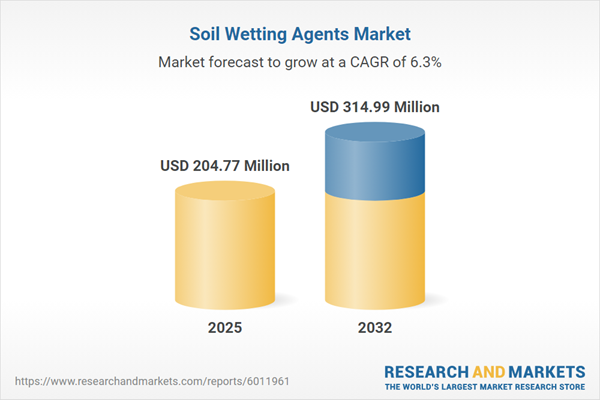Speak directly to the analyst to clarify any post sales queries you may have.
The soil wetting agents market is evolving rapidly as agricultural enterprises and land management stakeholders prioritize advanced solutions for sustainable water stewardship and compliance. This transformation is supported by expanded technology adoption, new business strategies, and a clear emphasis on addressing regional requirements and sustainability demands.
Market Snapshot: Soil Wetting Agents Market Size and Growth Outlook
The global soil wetting agents market is projected to grow from USD 192.65 million in 2024 to USD 314.99 million by 2032, representing a compound annual growth rate of 6.33%. Growth is primarily fueled by the widespread uptake of advanced water management practices, heightened regulatory standards, and demand for products considered environmentally favorable. The leading industry organizations are intensifying investments in R&D, focusing on innovative formulations that fulfill both commercial and regulatory objectives. Efforts in this space contribute to sustained operational efficiency and long-term market presence in a shifting competitive environment.
Scope & Segmentation: Strategic Opportunities in the Soil Wetting Agents Market
Comprehensive segmentation in the soil wetting agents sector enables senior leaders to efficiently align resources while responding to operational and regulatory complexity:
- Type: Amphoteric, anionic, cationic, and nonionic surfactants are tailored to distinct agronomic, horticultural, and restoration project needs, supporting both specialized and broad-spectrum use cases as well as regulatory compliance.
- Form: Granular, liquid (including emulsifiable and suspension concentrate options), and powder forms provide compatibility with both digital farming systems and traditional application tools, promoting agility in solution delivery.
- Crop Type: Field crops, forestry, horticulture, turf, and ornamentals each benefit from targeted wetting agent strategies to optimize performance across commercial and ecological restoration scenarios.
- Application Method: Foliar sprays, drip or sprinkler irrigation, seed treatments, and soil drenches enable precise use in a variety of environmental and soil conditions.
- Distribution Channel: Agrochemical dealers, direct sales, e-commerce, and retail channels meet procurement needs for enterprise buyers and specialists focused on soil health management.
- Region: Americas, Europe, Middle East & Africa, and Asia-Pacific feature distinct regulatory frameworks, operational constraints, and opportunities, requiring region-specific strategies for market entry and compliance.
- Key Companies: BASF SE, Stepan Company, Croda International Plc, Solvay S.A., Clariant AG, Evonik Operations GmbH, Akzo Nobel N.V., Aquatrols Corporation, Tessenderlo Group NV, and Helena Agri-Enterprises, LLC are shaping market standards for technology adoption and compliance practices.
Detailed segmentation supports more strategic targeting, facilitates technology integration in operations, and enhances compliance across business units.
Key Takeaways: Strategic Insights for Market Leaders
- Soil wetting agents drive consistent water distribution, enhancing plant health and yield resilience in varying soil conditions while supporting reliable crop outcomes.
- There is rising adoption of bio-based and environmentally responsive agents, opening new market channels in regions prioritizing sustainability within procurement mandates.
- Digital agriculture integration, especially through precision irrigation, empowers real-time resource allocation and improved monitoring, leading to more agile business operations.
- Regional market approaches demand adaptation: North America often adopts data-centric, integrated models, while Asia-Pacific demonstrates preference for flexible solutions attuned to local agricultural infrastructure and climate.
- Close collaboration between manufacturers, technology partners, and service providers reinforces supply chain stability and supports agile product development amid evolving compliance requirements.
- Enterprises that leverage cross-functional teams spanning regulatory, research, and distribution disciplines are positioned to anticipate market risks and effectively capture global opportunities.
Tariff Impact: Navigating Supply Chain and Margin Pressures
The introduction of forthcoming 2025 U.S. tariffs on soil wetting agents and associated raw materials is prompting executive teams to revisit sourcing strategies. Companies are optimizing supplier networks, assessing regional procurement, and renegotiating agreements to preserve both supply continuity and margins under new regulatory pressures.
Methodology & Data Sources
This analysis synthesizes industry publications, international regulatory reports, and specialist input from technical experts. In addition, patent activity and product pipeline reviews inform market trend and innovation insights.
Why This Report Matters
- Equips executive leaders to guide compliance initiatives, accelerate adoption of advanced technologies, and pursue innovation in soil wetting agent and agritech markets.
- Provides actionable perspectives for refining supply chain operations and resource allocation within complex, rapidly evolving business frameworks.
- Enhances situational awareness of new opportunities, facilitating both risk mitigation and continuity planning for long-term market positioning.
Conclusion
Senior decision-makers can apply these findings to inform operational strategy, remain ahead of regulatory and technology trends, and secure sustained competitiveness within the soil wetting agents market.
Additional Product Information:
- Purchase of this report includes 1 year online access with quarterly updates.
- This report can be updated on request. Please contact our Customer Experience team using the Ask a Question widget on our website.
Table of Contents
3. Executive Summary
4. Market Overview
7. Cumulative Impact of Artificial Intelligence 2025
Companies Mentioned
The companies profiled in this Soil Wetting Agents market report include:- BASF SE
- Stepan Company
- Croda International PLC
- Solvay S.A.
- Clariant AG
- Evonik Operations GmbH
- Akzo Nobel N.V.
- Aquatrols Corporation
- Tessenderlo Group NV
- Helena Agri-Enterprises, LLC
Table Information
| Report Attribute | Details |
|---|---|
| No. of Pages | 195 |
| Published | November 2025 |
| Forecast Period | 2025 - 2032 |
| Estimated Market Value ( USD | $ 204.77 Million |
| Forecasted Market Value ( USD | $ 314.99 Million |
| Compound Annual Growth Rate | 6.3% |
| Regions Covered | Global |
| No. of Companies Mentioned | 11 |









